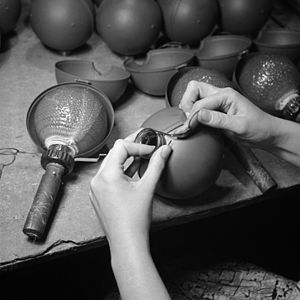
Back قنبلة لاصقة Arabic Sticky Bomb German Αντιαρματική χειροβομβίδα No. 74 Greek Granada antitanque n.º 74 Spanish بمب چسبنده Persian Sticky bomb French Bom lengket ID N°74 ST Italian No.74粘着手榴弾 Japanese 접착폭탄 Korean
| Sticky bomb | |
|---|---|
 Sticky bombs being manufactured | |
| Type | Anti-tank hand grenade |
| Place of origin | United Kingdom |
| Service history | |
| Used by | United Kingdom Canada Australia France |
| Wars | Second World War |
| Production history | |
| Designer | Stuart Macrae |
| Designed | 1940 |
| Manufacturer | Kay Brothers Company |
| Produced | 1940-1943 |
| No. built | 2.5 million |
| Specifications | |
| Mass | 2.25 lb (1.02 kg)[1] |
| Length | 9 in (230 mm) |
| Diameter | 4 in (100 mm) |
| Filling | Nitroglycerine (Nobel's No. 823 explosive)[1] |
| Filling weight | 1.25 lb (0.57 kg) |
Detonation mechanism | Timed, 5 seconds |
The "Grenade, Hand, Anti-Tank No. 74", commonly known as the S.T. grenade[a] or simply sticky bomb, was a British hand grenade designed and produced during the Second World War. The grenade was one of a number of ad hoc anti-tank weapons developed for use by the British Army and Home Guard after the loss of many anti-tank guns in France after the Dunkirk evacuation.
The grenade was designed by a team from MIR(c) including Major Millis Jefferis and Stuart Macrae. It consisted of a glass sphere containing an explosive made of nitroglycerin and additives which added stability. When the user pulled a pin on the handle, the casing would fall away and expose the sticky sphere. Pulling another pin would arm the firing mechanism and the user would attempt to attach the grenade to an enemy vehicle. Letting go of the handle would release a lever that would activate a five-second fuse, which would then detonate the nitroglycerin compound.
The grenade had several faults in its design. The Ordnance Board of the War Department did not approve the grenade for use by the British Army, but intervention by the prime minister, Winston Churchill, led to production of the grenade.[3] Between 1940 and 1943, approximately 2.5 million were produced. It was primarily issued to the Home Guard but was also used by British and Commonwealth forces in North Africa. It was used by Allied Forces on the Anzio Beachhead, including the First Special Service Force; as well as by Australian Army units during the New Guinea campaign. The French Resistance were also issued a quantity of the grenades.
- ^ a b OP1665 1946, p. 380.
- ^ Postan, Hay & Scott 1964, p. 268.
- ^ Churchill, Winston; Gilbert, Martin (1993). The Churchill War Papers: The ever-widening war, 1941. W. W. Norton & Company. ISBN 978-0-393-01959-9.
Cite error: There are <ref group=lower-alpha> tags or {{efn}} templates on this page, but the references will not show without a {{reflist|group=lower-alpha}} template or {{notelist}} template (see the help page).
© MMXXIII Rich X Search. We shall prevail. All rights reserved. Rich X Search